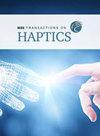Direction-Specific Effects of Artificial Skin-Stretch on Stiffness Perception and Grip Force Control
IF 2.4
3区 计算机科学
Q2 COMPUTER SCIENCE, CYBERNETICS
引用次数: 0
Abstract
When interacting with an object, we use kinesthetic and tactile information to create our perception of the object's properties and to prevent its slippage using grip force control. We previously showed that applying artificial skin-stretch together with, and in the same direction as, kinesthetic force increases the perceived stiffness. Here, we investigated the effect of the direction of the artificial stretch on stiffness perception and grip force control. We presented participants with kinesthetic force together with negative or positive artificial stretch, in the opposite or the same direction of the natural stretch due to the kinesthetic force, respectively. Our results showed that artificial skin-stretch in both directions augmented the perceived stiffness; however, the augmentation caused by the negative stretch was consistently lower than that caused by the positive stretch. Additionally, we proposed a computational model that predicts the perceptual effects based on the preferred directions of the stimulated mechanoreceptors. When examining the grip force, we found that participants applied higher grip forces during the interactions with positive skin-stretch in comparison to the negative skin-stretch, which is consistent with the perceptual results. These results may be useful in tactile technologies for wearable haptic devices, teleoperation, and robot-assisted surgery.人造皮肤拉伸对刚度感知和握力控制的定向影响。
当与物体互动时,我们使用动觉和触觉信息来创造我们对物体属性的感知,并使用握力控制来防止其滑动。我们之前的研究表明,将人工皮肤拉伸与动觉力同时施加,并在相同的方向上,会增加感知到的僵硬度。在此,我们研究了人工拉伸的方向对刚度感知和握力控制的影响。我们分别向被试呈现动觉力和负或正的人工拉伸,与由动觉力引起的自然拉伸方向相反或相同。我们的结果表明,人工皮肤在两个方向上的拉伸都增加了感知刚度;然而,负拉伸引起的增强始终低于正拉伸引起的增强。此外,我们提出了一个计算模型,该模型基于受刺激的机械感受器的首选方向来预测感知效应。当检查握力时,我们发现参与者在积极的皮肤拉伸过程中比消极的皮肤拉伸过程中施加了更高的握力,这与感知结果是一致的。这些结果可能对可穿戴触觉设备、远程操作和机器人辅助手术的触觉技术有用。
本文章由计算机程序翻译,如有差异,请以英文原文为准。
求助全文
约1分钟内获得全文
求助全文
来源期刊

IEEE Transactions on Haptics
COMPUTER SCIENCE, CYBERNETICS-
CiteScore
5.90
自引率
13.80%
发文量
109
审稿时长
>12 weeks
期刊介绍:
IEEE Transactions on Haptics (ToH) is a scholarly archival journal that addresses the science, technology, and applications associated with information acquisition and object manipulation through touch. Haptic interactions relevant to this journal include all aspects of manual exploration and manipulation of objects by humans, machines and interactions between the two, performed in real, virtual, teleoperated or networked environments. Research areas of relevance to this publication include, but are not limited to, the following topics: Human haptic and multi-sensory perception and action, Aspects of motor control that explicitly pertain to human haptics, Haptic interactions via passive or active tools and machines, Devices that sense, enable, or create haptic interactions locally or at a distance, Haptic rendering and its association with graphic and auditory rendering in virtual reality, Algorithms, controls, and dynamics of haptic devices, users, and interactions between the two, Human-machine performance and safety with haptic feedback, Haptics in the context of human-computer interactions, Systems and networks using haptic devices and interactions, including multi-modal feedback, Application of the above, for example in areas such as education, rehabilitation, medicine, computer-aided design, skills training, computer games, driver controls, simulation, and visualization.
 求助内容:
求助内容: 应助结果提醒方式:
应助结果提醒方式:


